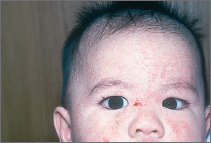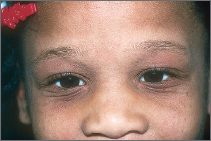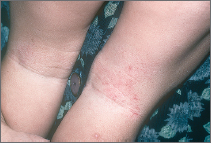Atopic dermatitis, which is sometimes called atopic eczema or hereditary eczema, is a very common, itchy, sensitive skin condition that runs in certain families.
It may flare up at times of stress or during the change of seasons, or it may just appear for no obvious reason. The problem frequently goes away by itself—in 40% to 50% of children—but it may return in adolescence or adulthood and possibly turn out to be a lifelong problem.
Atopic dermatitis
You, your child, or other family members may have one or more of the following symptoms in addition to the skin rash: dry, sensitive skin; allergies to medications, pollen, dust, house dust mites, ragweed, dogs, or cats; or other problems such as persistent runny nose, sinusitis, sneezing attacks, or chronic itchy or irritated eyes. Any one of these symptoms helps to suggest that atopic dermatitis is the cause of the chronic skin rash.
Other relatives (aunts, uncles, cousins, and grandparents) also may have similar symptoms.
Although most cases begin in childhood (often in infancy), atopic dermatitis may start at any age and has an unpredictable course.
Atopic dermatitis
The foundation of treatment for atopic dermatitis is the application of topical steroids.
Topical steroids are safe if used as directed and should be applied only for short periods of time, if possible, and only for active disease (i.e., itching and redness).
Topical steroids should be stopped when the skin is healed, and they should not be used to prevent future rashes.
Atopic dermatitis
Noncortisone topical treatments
Tacrolimus (Protopic) ointment and pimecrolimus (Elidel), which contain no steroids, have been shown to reduce the symptoms of atopic dermatitis.
They may be used on a very nonregular basis in children older than 2 years of age. They are applied twice daily to limited areas where topical steroids should be used with caution, such as the eyelids, underarms, and genitals.
Oral antihistamines such as hydroxyzine (Atarax) or the over-the-counter diphenhydramine (Benadryl) and chlorpheniramine (Chlor-Trimeton) probably won't reduce itching, but they can be helpful if they bring about drowsiness or sleep.
Sun exposure, ideally in the early morning, may improve the condition.
Chronic atopic dermatitis
No, but atopic dermatitis can be kept under control, and sometimes it clears up by itself for long periods of time—sometimes permanently!
Avoid or lessen exposure to possible trigger factors such as dry skin, irritants, harsh soaps, bubble baths, overheating, sweating, and allergens.
Avoid bathing every day. Bathing is fine for most infants but isn't necessary. If your child has sensitive skin, it might be best to bathe him or her every other day. For some infants, daily baths can make the skin dry and irritated. Bathing can also cause flare-ups in infants with eczema.
Apply moisturizers, particularly in the dry winter months, immediately after bathing, to “trap” water in the skin. Suggested products include__________ or __________.
Use barrier creams such as _______________, which may work better than simple moisturizers in preventing atopic dermatitis.
Outline




